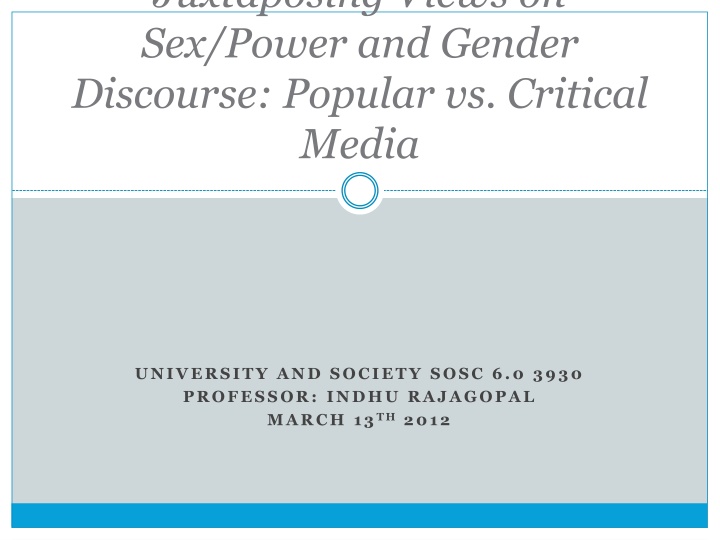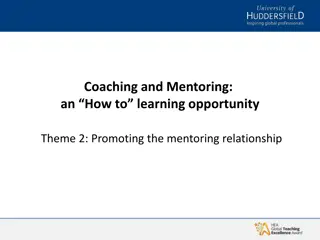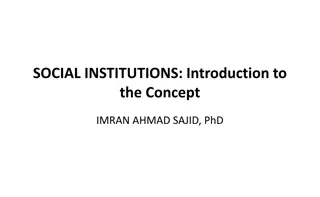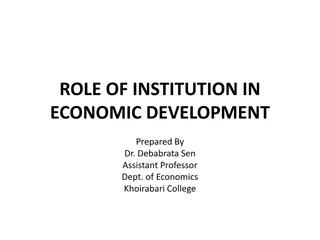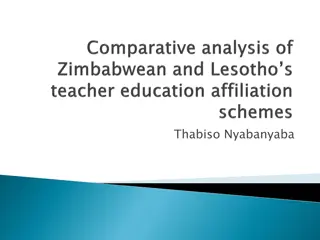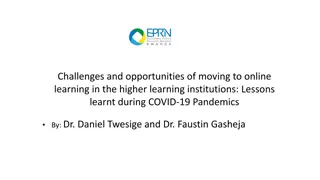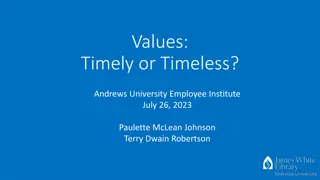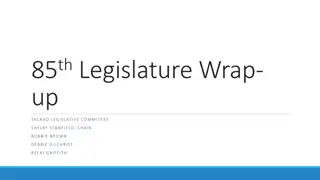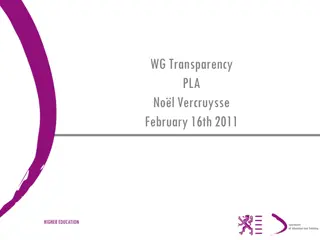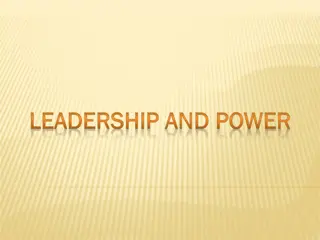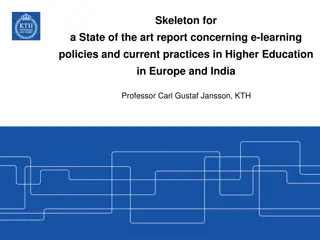Examining Power Dynamics in Higher Education Institutions
This presentation delves into the intricate intersection of sex, power, and gender discourse in higher education. It explores how oligarchic structures within academic settings impact female identity formation. Through the lens of theorists like Foucault, it analyzes the control mechanisms shaping the docile female body and the reinforcement of masculinity through power dynamics and knowledge dissemination. The presentation aims to uncover the often hidden power relations at play and prompt critical discussions on gender in educational spaces.
Uploaded on Sep 27, 2024 | 2 Views
Download Presentation

Please find below an Image/Link to download the presentation.
The content on the website is provided AS IS for your information and personal use only. It may not be sold, licensed, or shared on other websites without obtaining consent from the author.If you encounter any issues during the download, it is possible that the publisher has removed the file from their server.
You are allowed to download the files provided on this website for personal or commercial use, subject to the condition that they are used lawfully. All files are the property of their respective owners.
The content on the website is provided AS IS for your information and personal use only. It may not be sold, licensed, or shared on other websites without obtaining consent from the author.
E N D
Presentation Transcript
Juxtaposing Views on Sex/Power and Gender Discourse: Popular vs. Critical Media UNIVERSITY AND SOCIETY SOSC 6.0 3930 PROFESSOR: INDHU RAJAGOPAL MARCH 13TH2012
Presentation Outline Part one - Central thesis and variables explored - Theorists utilized - Main findings Part two - Thesis - Theorists utilized - Subtopics and themes explored - Opposing argument and rebuttal - Popular and critical media sources - Main findings Concluding thoughts Discussion questions
Part One An Inquiry into the Visible and Invisible Oligarchy of Gender Power in Higher Education
Part One Purpose: Fill the void in academic discussions which have failed to adequately capture the processes that shape female identity in organizations of higher education. Thesis: Within this essay, I argue that oligarchic and elitist power structures present in institutions of higher education fundamentally subvert female identity to produce docile bodies.
Variable One The Body For Foucault, the body exists in society where it is incessantly controlled, disciplined and made to conform to societal norms. Integral role in shaping, enforcing, and reinforcing constructions of the docile female body. Institutions of higher education as repositories of knowledge.
Variable Two Power Foucault stresses that power is a relation that exists at and in every level of society Power is used extensively to standardize behavior and establish strict forms of identity The fortification of masculine superiority.
Variable Three Knowledge and Discourse From a Foucauldian perspective, knowledge is to be understood as an instrument through which power and authority is exerted. The university is at the core of the creation and dissemination of knowledge. The interests of elitist knowledge claims preserve the traditional paradigm of gender inequality.
Theorists Utilized Theorists used in discussing the body and higher education Azzarito Future Girls, transcendent femininities and new pedagogies: toward girls' hybrid bodies? (2004) Debra Merskin Reviving Lolita? A Media Literacy Examination of Sexual Portrayals of Girls in Fashion Advertising. (2010) Taylor and Setters Watching Aggressive, Attractice, Female Protagonists Shapes Gender Roles for Women Among Male and Female Undergraduate Viewers (2011) Theorists used in discussing power and higher education Emily Kane Education and Beliefs About Gender Inequality (1995) Petra Verdonk et al. Should you turn this into a complete gender matter? Gender mainstreaming in medical education (2009) Mino Vianello Gender Differences in Access to and Exercise of Power (2004) Theorists used in discussing knowledge and discourse in higher education Ruth Watts Whose Knowledge? Gender, Education, Science and History (2007) Carinci Sherrie Does gender matter? An exploratory study of perspectives across genders, age and education (2009)
Part One : Main Findings and Formulating Points of Resistance The proclivity to produce docile female bodies is systematically ingrained in the structure of institutions of higher education and thus is difficult to overcome. However, where there is power there is also resistance. A reconceptualization of knowledge and the body. A multi-dimensional approach utilizing both subtle and overt forms of resistance that serve to heighten women s status and position in oligarchic power systems in higher education.
Part Two Juxtaposing Views on Sex/Power and Gender Discourse: Popular vs. Critical Media
Central Thesis Thesis: I argue that representations of sex relations and gender discourses expressed in popular media exacerbate stereotypical constructions of femininity and the female body which is disciplined, normalized and controlled. The portrayal of female docility in the popular press is juxtaposed with critical media sources, from which it is asserted offer emancipatory and positive constructions of the female body that challenge and resist normalization and discipline.
Foucauldian Framework Arguments for part two of my research project are grounded in the works of Michel Foucault, most particularly his discussions on the body, disciplinary power and knowledge and discourse. Examine the role of these three Foucauldian concepts in relation to popular and critical media sources. This framework will also assist in exploring how the media simultaneously acts to privilege and solidify male superiority.
Process of Docility Objectified and Surveyed Normalization Disciplined Female Docility
Subtopic One: Representations of the Body Popular Media Popular media sources both covertly and overtly sexualize the female body. The female body is commodified, and to adopt Foucault s conceptualizations, it is disciplined and made available to the male gaze. Bufkin and Eschholz (2000) The authors critique the prevalence of such representations in the popular media (most regularly depicted in the horror genre ), suggesting that they serve to reassert the patriarchal vision of gender and the controlled docile female body.
Subtopic One: Representations of the Body Continued Critical Media In contrast to the popular media, critical media sources offer a counter or resistant construction of the female body. This argument is substantiated in Thorpe s (2008) explication of femininity in snowboarding. Discursive constructions of the female body are varied and range from women as respected athletes to female snowboarders as cultural participants.
Subtopic Two: Representations of Disciplinary Power Popular Media Popular media conforms to stereotypical notions of femininity and masculinity (ie. the passive female dichotomized with the aggressive, macho male figure). Consistent with this argument, Azzarito (2010) utilizes a Foucauldian inspired analysis. Popular media formats encourage women to engage in self-discipline in order to conform to dominant norms of feminine docility.
Subtopic Two: Representations of Disciplinary Power Continued Critical Media Critical media sources inverse the power relation by diversifying the images and rhetoric surrounding gender. Luke (1994) reinforces this claim, stressing that critical culture empowers individuals Critical media sources question the flawed misrepresentations of female docility and discipline found in the popular media.
Subtopic Three: Discourse and Knowledge Popular Media The popular media disseminates common-sense knowledge that is met with little scrutiny. Discourses and knowledge produced by the popular media are a manifestation of wider patriarchal values. Ross and Carter (2011) elucidate on this issue, noting that news programming privileges male voices over women s voices .
Subtopic Three: Discourse and Knowledge Continued Critical Media In the realm of Foucault s discourse and knowledge, critical communication mediums are again positioned in stark contrast to the popular media. Knowledge claims in the critical media scrutinize and serve to contradict those found in popular mediums. As Kelly and Stack (2006) affirm, critical sources assist in democratizing the media by presenting resistant strategies, narratives and knowledge. Applying Foucault s concepts of connaissance (popular media) vs. savoir (critical media).
Oppositional Argument Critics may contend that it is incorrect to only problematize the popular media while neglecting the critical media as a facilitator of female docility. Critical communication mediums fail to offer policies or practices to overcome such issues. A lack of pragmatic relevancy. Thus, the critical media is also responsible for exacerbating the processes of normalization that discipline female identity.
A Refutation and Rebuttal In rebuttal, I suggest that the critical media , in its tendency to challenge norms presented by the popular media sources, may serve as a transformative educational instrument. A resource that offers alternative narratives that may elevate the status and social position of women. This refutation is based within Tisdell s (2008) argument, that asserts the significance of the critical media as a grounding for developing a counter hegemonic resistance that challenges and undermines existing disciplinary processes that construct the docile female.
Popular Media Examples Desperate Housewives (2004) A prominent comedy/drama series that depicts the lives of a group of female housewives. The women within the program are explicitly sexualized and objectified, as the lifestyles of the female characters are often premised on their sexual desires and promiscuity.
Popular Media Examples Continued Film: Easy A (2010) A film that is premised on a young, female character who deceits her peers in order to convince them that she has lost her virginity. An illustration of the sexual commodification and normalization of women whose worth is judged by their conformity as docile, passive sexual objects.
Popular Media Examples Continued Female Perfume Advertisements: Magazines, television programs and a host of other popular media sources feature advertisements directed at female consumers. Most notably in the realm of female perfume advertisements, woman are featured in passive, and docile suggestive poses and objectified through the commodification of their bodies. The sexualization of the female body becomes normalized as a routine aspect of everyday life . http://www.youtube.com/watch?v=76lPciEip3A
Critical Media Examples A critical cartoon that discusses the sexual objectification and exploitation of women, and hegemonic patriarchal discourses more generally. In representing the male gaze as primitive and savage like , the cartoon essentially mocks male dominance.
Critical Media Examples Continued A critical cartoon that critiques the stereotypical and normalized portrayal of women in magazines. In so doing, it problematizes the tendency of popular media sources to portray females as slender, passive subjects to be consumed.
Critical Media Examples Continued The cartoon is a deliberately hyperbolic depiction of gender norms that are ingrained in and enforced upon individuals from youth. Analyzing this cartoon from a Foucauldian perspective, it is evident that gender is a social construction, that is utilized as a means of maintaining the disciplinary subversion of women.
Foucaults Construction of Docile Bodies Cellular (located bodies in enclosures) Organic (Specified repetitive activities) Genetic (Trained and timed in hard work of production) Combinatory (Division of labour and organizing ranks & classes as units of production- Marx, Capital, vol. 1. 311-12) (isolation)
Applying Foucaults Construction of Docile Bodies To The Media Cellular The body is spatially located in films, television programs and other popular media sources where it is objectified. Organic Consumers of popular media engage in repetitive tasks (ex. consistently viewing a television program at the same time each week) Genetic Female docility is produced and individuals are trained from birth to conform to gender roles (ex. as depicted within the previous critical cartoon, both males and females are expected to play with toys that have been deemed appropriate for their gender.) Division of Labor Though not a division of labor per se, popular media does indeed provide clear ranks consistent with the wider patriarchal society (ex. the female gender is subversive and secondary to the male gender)
Future Directions How can the critical media can be harnessed as a tool for progressive social development in the realm of gender/sex and power. Advocating the critical media as an emancipatory and positive instrument for challenging existing disciplinary hegemonic gender norms. The critical media may serve as a basis for reconstituting the female body and discourses on femininity.
Concluding Thoughts There is a sharp distinction in the narratives, images and discourses presented in popular media sources on the one hand and critical communication mediums on the other. Juxtaposing these sources assists in understanding their impact in shaping the manipulation and engineering of the docile female body.
Discussion Questions In light of the arguments presented here, it is viable to conceive of the critical media as an instrument to challenge the discourses and narratives found within the popular media? What other measures or steps can be taken, beyond the critical media, to elevate the status of women and undermine the construction of female docility?
Works Cited Course Literature Azzarito Future Girls, transcendent femininities and new pedagogies: toward girls' hybrid bodies? Sport, Education and Society. 15:3 (2010): 261-275. Blackman, L. (2004). Indhu Rajagopal. Lecture 1 . York University. September 20 2011. Lecture. Indhu Rajagopal. Lecture 3 . York University. October 4 2011. Lecture. Merskin, D. Reviving Lolita? A Media Literacy Examination of Sexual Portrayals of Girls in Fashion Advertising. American Behavioral Scientist. 48:1 (2004): 119-129. Taylor, L.D. & Setters, T. Watching Aggressive, Attractive, Female Protagonists Shapes Gender Roles for Women among Male and Female Undergraduate Viewers Sex Roles. 65 (2011): 35-46.
Works Cited Continued Outside Sources Bradshaw, Pat and Stephanie Newell. Dreams of untenured female faculty: exploring the deep structures of power. Canadian Woman Studies. 18. 1 (Spring 1998): 123-127. Carinci, Sherrie, and Pia Lindquist Wong. "Does gender matter? An exploratory study of perspectives across genders, age and education." International Review of Education. 55.5 (2009): 523-540. Denker, Katherine. "Doing Gender in the Academy: The Challenges for Women in the Academic Organization." Women and Language. 32.1 (2009): 103-112. Jesse, Jolene. Redesigning Science: Recent Scholarship on Cultural Change, Gender, and Diversity. BioScience. 56. 10 (2006): 831-838. Kane, Emily. "Education and Beliefs about Gender Inequality." Social Problems. 42.1 (1995): 74-90. Verdonk, Petra, Toine Lagro-Janssen, Linda Mans, Hanneke de Haes and Yvonne Benschop. "'Should you turn this into a complete gender matter?' Gender mainstreaming in medical education." Gender and Education. 21.6 (2009): 703-719. Vianello, Mino. "Gender Differences in Access to and Exercise of Power." Current Sociology. 52.3 (2004): 501-518. Watts, Ruth. "Whose Knowledge? Gender, Education, Science and History." History of Education. 36.3 (2007): 283- 302.
Works Cited Continued New Articles on Media Carmen Luke. Feminist Pedagogy and Critical Media Literacy. Journal of Communication Inquiry. 18:2 (1994): 30-47. Geertsema, Margaretha. Women And News. Feminist Media Studies. 9:2 (2009): 149-172 Jana Bufkin and Sarah Eschholz. Images of Sex and Rape: A Content Analysis of Popular Film. Violence Against Women. 6:12 (2002): 1317-1344 Karen Ross and Cynthia Carter Women and news: A long and winding road Course Literature. Media Culture and Society. 33:8 (2011) 1148-1165 Michelle Stack and Deirdre Kelly. Popular Media, Education, and Resistance. Canadian Journal of Education. 29:1 (2006): 5-26. Ramona Rush et al. A Global Hypothesis for Women in Journalism and Mass Communications: The Ratio of Recurrent and Reinforced Residuum. 67:3 (2005): 239-253 Steinke, Jocelyn. Cultural Representations of Gender and Science: Portrayals of Female Scientists and Engineers in Popular Films. Science Communication. 27:1 (2005): 27-63 Tisdell, Elizabeth. Critical Media Literacy and Transformative Learning: Drawing on Pop Culture and Entertainment Media in Teaching For Diversity in Adult Higher Education. Journal of Transformative Education. 6:1 (2008): 48-67
